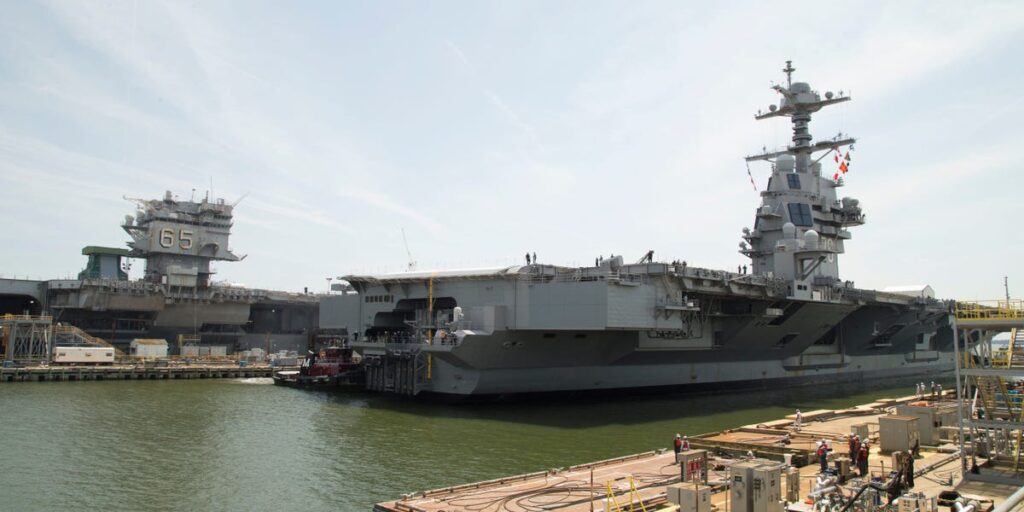The US Navy faces significant problems keeping its ships ready to sail. President Donald Trump’s pick for top admiral says that he is looking to cruise lines for ideas.
The Navy has long been interested in what it can learn from cruise lines, like how to stick to planned maintenance schedules, but the sea service faces challenges in adopting those lessons and ensuring readiness, naval affairs experts says.
Last week, Adm. Daryl Caudle, Trump’s nominee for chief of naval operations, told the US Senate Armed Services Committee that the Navy needed to fix how it conducted ship maintenance.
“And learning from the best in the world,” he said, referencing some cruise ship companies, “certainly should be on the table.”
He noted that during Miami Fleet Week earlier this year, he’d met with executives from Norwegian Cruise Line, and that the Navy was working with Carnival Cruise Line on the issue.
Last fall, Caudle said during the Fleet Maintenance & Modernization Symposium that borrowing industry practices was vital, explaining that the Navy is “looking across industries like shipping and cruise lines for ideas and best practices to improve maintenance and modernization by the professionals that are financially motivated for their business survival.”
While Caudle and other Navy officials have acknowledged differences between fixing military vessels and cruise ships, such as various classes of ships and capabilities, the service is taking steps to see what practices are applicable — and how they can be implemented in order to fix maintenance woes.
Chronic maintenance problems
The Navy has been dealing with issues tied to regularly scheduled maintenance for its ships for decades. These range from shipyard backlogs and limited dry dock availability at a small number of shipyards to scheduling errors, workforce shortages, lack of clear and consistent data, and more repair work being needed than expected.
Earlier this year, the US Government Accountability Office, a watchdog agency, tracked many of these persistent issues, including shortages of spare parts and materials. Previously, the GAO assessed that between the 2015 and 2020 fiscal years, 75% of planned maintenance availabilities were delayed.
Many of these problems run concurrently with larger Navy shipbuilding problems and have raised questions in Washington, the service, and across experts and observers about whether the Navy can adequately maintain its force while shipbuilding delays slow the process of acquiring new ones. And then there’s the big question about what that could mean in a high-end fight against an adversarial power like China.
Cruise lines could have some answers
The Navy has acknowledged that it could take a page or two from some of the world’s biggest commercial cruise lines. In 2019, then-Secretary of the Navy Richard Spencer revealed that Navy personnel “spent some time with Carnival Cruise Line,” saying he was impressed that “they turn a 700-foot floating hotel on a maintenance avail around in 28 days,” while it can take the Navy months, even years to turn some ships around.
And earlier this year, prior to his retirement, Rear. Adm. William Greene said that the Navy was partnering with cruise lines to develop better maintenance skills. The Navy is eager to get its surge readiness rates up to 80% by 2027.
The Navy could learn lessons in planning and scheduling from cruise companies, as well as others on reducing dry dock wait times and having clearer pictures of the work that vessels will require before the ships get to the yard.
The key approach for cruise lines is sticking to consistent and planned schedules.
“The ships go into refits and overhaul at specified periodicities, and the condition of the ship is predictable because the operational profile is well known,” Bryan Clark, a retired Navy submarine officer and defense expert at the Hudson Institute, told Business Insider.
Clark said there is more the Navy can do to stick with planned maintenance schedules and push back against changes. Alternative ways to meet operational needs are also an option. The Navy can also “ensure the work package reflects assessments done on the ship before it enters the maintenance period,” he added, so that unforeseen problems with the vessel don’t arise while it’s being worked on.
Challenges in adoption
The Navy’s schedules change for a number of reasons including where the fleet needs to be deployed around the world, what specific classes of vessels and capabilities need to be available, and how those requirements fit with vessels that are already undergoing maintenance.
Similarly, the condition of Navy ships isn’t as well known or predictable as cruise ships. There could be specific problems related to a ship’s systems or weapons, and there are then processes for those who are specifically authorized to fix that.
One big issue facing Navy maintenance is the limits on the “right to repair” for sailors at sea. During his confirmation hearing, Caudle said sailors aboard Navy vessels needed better training and authorization to repair equipment while underway, saying, “We can’t rely on a contractor’s permission to do maintenance in the middle of the ocean.” That said, the issues run much deeper for the Navy.
Read the full article here
















